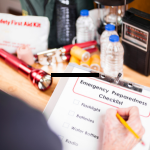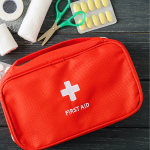Be prepared
Cyclones, storms, floods and fire are a part of life in Noosa, and it's easy to become complacent. It's not a matter of 'if' but 'when'.
Queensland is the most natural disaster impacted state in Australia, exposing our communities and infrastructure to repeated damage.
You can't control the weather or when the next disaster will hit Queensland, but you can be aware and prepared. Get Ready Queensland helps you to take the steps to protect what’s most important to you.
During disasters, emergency services might not be able to reach you because of high winds, fire, floodwater, fallen powerlines or debris across the road. Emergency services will be focused on assisting the most vulnerable in the community during an event.
That's why you need to be prepared to evacuate or 'camp indoors' for at least three days.
Don't wait for a disaster to happen before you think about how you and your family are going to survive.
Before a disaster

Don't wait for a disaster to happen before you think about how you and your family are going to survive.
View council's Noosa Emergency Action Guide for practical information on:
- Preparing your emergency plan
- Preparing your emergency kit and evacuation kit
- Preparing your family, pets, home, yard and belongings.
During a disaster

In the event of a disaster or emergency, stay calm, follow your prepared emergency plans and, if possible, tune into the local Sunshine Coast ABC radio station to stay informed and follow instructions from authorities promptly.
Rules of thumb
The following are some handy rules of thumb depending on your situation and the type of disaster or emergency:-
- Cyclone/storm tide – run from water – shelter in place from wind;
- Riverine flooding – stay with friends in high places;
- Bushfire – if you are going to leave, leave early;
- Hazardous material accident – stay upwind or stay inside;
- Tsunami – go inland one kilometre or go up ten metres;
- Dam release – get out and move to higher ground quickly.
Make sure you remember to:
- Check weather updates and if local roads are closed on the local disaster dashboard.
- Do not enter flood waters (for example roads, causeways, creeks etc.). Not on foot, rubber dinghy, body board or in your vehicle. If it's flooded – forget it.
- Check on neighbours and people who may need your assistance.
- Think about the needs of your animals (pets) and where you will take them.
- Look out for fallen power lines.
- Check that your drinking water is not contaminated and ensure your food safety. Visit the Queensland Health website for further information on community health during disasters.
-
Evacuation involves the planned movement of people from an unsafe or potentially unsafe location to a safer location, and their eventual return.
When evacuations become necessary, you will be told through the media or by other warning methods. These methods include sirens or telephone calls using the emergency alert system. This includes an SMS message to your mobile or a voice message to your landline within a defined geographic area.
-
- Self-evacuation: No formal authority required, you can choose to self-evacuate at any time if you don't feel safe. But please let someone know that you are evacuating and where you are going.
- Voluntary evacuation: The Local Disaster Management Group (LDMG) in consultation with the District Disaster Coordinator will ask people in a particular area to voluntarily evacuate.
- Directed evacuation: You are ordered to 'evacuate now' by the authority of the District Disaster Coordinator. At this stage council will advise what evacuation centres will be opened.
Note: A declaration of a disaster situation is required for directed evacuation.
-
Evacuation Centres will be opened as required depending on the location and type of emergency or disaster.
In the event of an emergency, it may be necessary for Council to open one or more evacuation centres.
- If you are directed to evacuate, you will be advised by local radio and television, and on Council's Facebook and Disaster Dashboard which centres are open.
- You cannot take alcohol or weapons to an evacuation centre but you can take domestic pets.
- Before going to an evacuation centre, you should seek refuge with family or friends.
- Evacuation centres should only be used if you have nowhere else to go.
- Evacuation centres are not ‘cyclone shelters' and are not designed to protect against high winds or windborne debris.
- You will be requested to register at the nearest open evacuation centre.
- Do not go to any evacuation centre unless officially advised.
Register.Find.Reunite
During an emergency, registering with Register.Find.Reunite can help people reconnect with family and friends.
Note: This service is launched only during emergency situations.
-
One of the instructions you may be given in a cyclone or an emergency is to 'shelter in place'. This occurs sometimes during cyclones or when hazardous materials may have been released into the atmosphere.
This is a precaution aimed to keep you safe while remaining indoors. This does not mean to go out to another shelter.
'Shelter in place' means selecting a small, interior room, with no or few windows, and taking refuge there. It does not mean sealing off your entire home or office building. If you are told to 'shelter in place', follow these instructions:
At home
- Close and lock all windows and exterior doors.
- If you are told there is danger of explosion, close the window shades, blinds, or curtains.
- Turn off all fans, heating and air conditioning systems.
- Close the fireplace damper.
- Get your family disaster emergency kit and make sure the radio is working.
- Go to an above ground interior room without windows.In the case of a chemical threat, an above-ground location is preferable. Some chemicals are heavier than air, and may seep into basements even if the windows are closed.
- Bring your pets with you, and be sure to bring additional food and water supplies for them.
- It is ideal to have a hard-wired telephone in the room you select. Call your emergency contact and have the phone available if you need to report a life-threatening condition. Mobile telephone equipment may be overwhelmed or damaged during an emergency.
- Seal all cracks around the door and any vents into the room. Use duct tape and plastic sheeting as it is heavier then food wrap.
- Keep listening to your radio or television until you are told all is safe or you are told to evacuate. Local officials may call for evacuation in specific areas at greatest risk in your community.
In your vehicle
- If you are very close to home, your office, or a public building, go there immediately and go inside. Follow the 'shelter in place' recommendations for the place you pick described above.
- If you are unable to get to a home or to a building quickly and safely, then pull over to the side of the road. Stop your vehicle in the safest place possible.
- If it is sunny outside, it is preferable to stop under a bridge or in a shady spot, to avoid being overheated.
- Turn off the engine. Close windows and vents.
- If possible, seal the heating/air conditioning vents with duct tape.
- Listen to the radio regularly for updated advice and instructions.
- Stay where you are until you are told it is safe to get back on the road. Be aware that some roads may be closed or traffic detoured. Follow the directions of police.
Remember that instructions to 'shelter in place' are usually provided for durations of a few hours, not days or weeks. There is little danger that the room in which you are taking shelter will run out of oxygen and you will suffocate.
Note: Do not run a petrol generator in the room in which you are sheltering as people have died in these circumstances from the fumes.
After a disaster
Natural disasters can be extremely challenging for the people directly affected by them, and they can impact the wider community. Returning to normality after a disaster may be quick or difficult and prolonged.
If the event has been severe, the Local Disaster Management Group will establish a Recovery Committee to:
- ensure people's wellbeing
- rebuild essential infrastructure
- help economic recovery
- rehabilitate the environment
Food Safety
Please read the Food Safety Update and the Food Safety In An Emergency leaflet for recommendations on what to do after an emergency. If you have water tanks, it is important to read this Fact Sheet
Staying safe and healthy after storms, cyclones and floods
Following the initial damage to property and infrastructure caused by storms, floods and cyclones, sickness and injury can still occur. Please see the Fact Sheet for more information.
Mental Health and Wellbeing Support
The Red Cross has published a series of resources to help people recover from the effects of disaster.
Crisis support is available through organisations such as Lifeline. Call Lifeline on 13 11 14 or log onto the Lifeline website.
Funding assistance
Following major disasters, the State and Federal Governments offer assistance. Crisis support is available through organisations such as Lifeline. Call Lifeline on 13 11 14 or log onto the Lifeline website.
